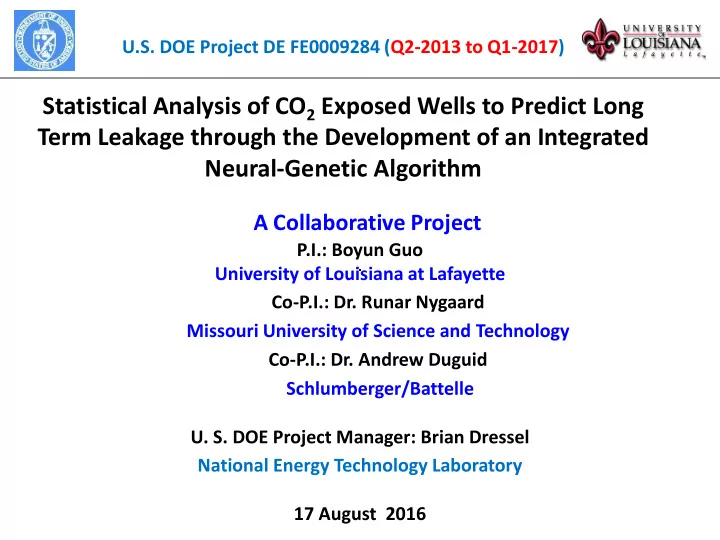

U.S. DOE Project DE FE0009284 (Q2-2013 to Q1-2017) Statistical Analysis of CO 2 Exposed Wells to Predict Long Term Leakage through the Development of an Integrated Neural-Genetic Algorithm A Collaborative Project P.I.: Boyun Guo University of Louisiana at Lafayette Co-P.I.: Dr. Runar Nygaard Missouri University of Science and Technology Co-P.I.: Dr. Andrew Duguid Schlumberger/Battelle U. S. DOE Project Manager: Brian Dressel National Energy Technology Laboratory 17 August 2016
Outline • Objective of Project • Methodology • Project Schedule • Accomplishments to Date – Data Mining – Software Development – Field Testing & Data Analysis • Summary
Objective of Project The overall objective of this project is the development of a novel computer model for predicting long-term leakage risks of wells exposed to CO 2 . The final goal is to deliver DOE and public a useful tool for evaluating the risk of long-term leakage of wells in future CO 2 sequestration projects.
Methodology • Create likely leakage scenarios for specific well attributes (injection wells, producing wells, abandoned wells, and wells subjected to corrosion). The goal of this stage is to understand the major leak mechanisms in different well conditions. • Develop a neural-genetic algorithm model to predict leakage risks for CO2 – exposed wells. The goal of this stage is to develop a comprehensive computer model ready to be validated using field data. • Verify model results by conducting field sampling including side wall cores samples, pressure testing data, and well logs of existing wells and compare the results with the model’s results. This is a stage to verify the accuracy of the computer model with field data.
Project Schedule Team Member and Year 2013 2014 2015 Role Quarter Q1 Q2 Q3 Q4 Q1 Q2 Q3 Q4 Q1 Q2 Q3 Q4 Task 1: Project Management Guo (PI), Nygaard (Co- and Planning PI), Duguid (Co-PI) Guo (PI), Nygaard (Co- Task 2: Data Mining PI), Duguid (Co-PI) Task 3: Statistical Analysis of Nygaard (Co-PI) Database Phase I Phase II Task 4: Developing Leakage Guo (PI), Nygaard (Co- Scenarios PI), Duguid (Co-PI) Task 5: Constructing Guo (PI), Sedaghat Preliminary Neural-Genetic and Li (programmers) Algorithm
Team Member and 2017 Year 2014 2015 Role Quarter Q1 Q2 Q3 Q4 Q1 Q2 Q3 Q4 Q1 Q2 Q3 Q4 Task 6: Constructing Guo (PI), Sedaghat and Comprehensive Neural- Li (programmers) Genetic Algorithm Task 7: Field Work Confirmation of Duguid (Co-PI) Leakage Scenarios Phase II Phase III Task 8: Field Sample Guo (PI), Sedaghat and Analysis Li (data analysts) Task 9: Verification of Guo (PI), Sedaghat and Model with Field and Li (data analysts) Lab Results Task 10: Risk Study, Mitigation Actions, and Guo (PI), Nygaard (Co- Standard PI), Duguid (Co-PI) Recommendations
Accomplishments to Date Phase I: Data Mining Phase II: Neural-Genetic Modeling Phase III: Field Testing
Review of Phase I Oyster Bayou Oil field 8
Data Collected from 510 wells Oil CO 2 Injection Plugged Field Wells Wells Subtotal Oyster Bayou 56 372 428 West Hastings 27 55 82 TOTAL 83 427 510 9
72 parameter values for each well
Well Integrity Information A.Analytical solutions • The maximum permissible pressure (MaxPP) • The minimum permissible pressure (MinPP) B. Finite-element modeling • Mechanical loads • Thermal load
Staged approach to finite-element modeling including thermal and mechanical loads has been developed
The developed Finite Element model have been verified with analytical models for simple cases 60 Compressive Stress (MPa) 50 40 30 20 10 0 0.05 0.07 0.09 0.11 0.13 0.15 0.17 0.19 Radius (m) Radial Stress Analytical Hoop Stress Formation Analytical Hoop Stress Cement Analytical Hoop Stress Casing Analytical Radial Stress FE Hoop Stress FE
Finite Element Model for well integrity analysis shows that de-bonding can create leakage pathways during CO2 injection Actual CO 2 Injection Well (Schlumberger Carbon Services) Cores gathered along the production section Lab samples made to replicate cement composition to obtain material parameters.
Review of Phase II - Software Development - Neural-Genetic Model for CO2-Explosed wells - Finite Element Model for well integrity analysis - Field Work - logs - Pressure transient tests - Sidewall core samples
Neural-Genetic Model for CO2-Explosed wells True Predicted 2 +x 2 2 No. x 1 x 2 y=x 1 y normalized y normalized 1 9.61 8.73 168.565 0.991553 0.976585 2 7.49 1.9 59.7101 0.354095 0.361341 3 1.2 3.4 13 0.080559 0.076307 4 1.75 7.51 59.4626 0.352646 0.354708 5 2.46 7.11 56.6037 0.335904 0.338334 2 2 y x x 1 2
510 x 72 = 36,720
Leakage-safe Probability Index (LPI) 1. Well Schematic Indicator (WSI) 2. Cement Sheath Integrity Indicator (CSII) 3. Cement Type Indicator (CTI) 4. Well Age Indicator (WAI) LPI=f(WSI, CSII, CTI, WAI)
Preliminary Field Verification of the Model Cranfield field site in southwest Mississippi Well CFU31F2 - Cement sidewall core at 3 depths (7,900 ft – 9,800 ft) - Pressure data at 9,535ft - Micro de-bonding log at 9,000ft-10,000ft - Isolation scanner log 7,000ft-10,000ft Leakage-Safe Probability Index (LPI) = 0.780.
Cement sidewall core at 3 depths 7,900 9,530 9,800 21 21
Pressure data at 9,535ft Pressure Bit Penetration 5000 3 2.5 4000 Drill Bit Depth (in) Pressure (psi) 2 3000 1.5 2000 1 1000 0.5 0 0 0 2000 4000 6000 8000 10000 12000 Time (s) Formation pressure is 4,300psi Inner casing pressure: 1,750psi Minimum Permissible Pressure (MinPP) = 2,835psi
Micro debonding log at 9,000ft-10,000ft Micro debonding Liquid Gas or dry micro Bonded 9,000ft 10,00ft
Isolation scanner log 7,000ft-10,000ft Gas Liquid Cement 7,900ft 9,530ft 9,800ft
Field Testing & Data Analysis Dr. Andrew Duguid
Field Testing at Cranfield Field • SECARB’s Phase II Gulf Coast Stacked Storage Project • Characterization for Well Integrity – To be used in the overall project models • Two Wells – Samples in and above the production zone
Recommend
More recommend